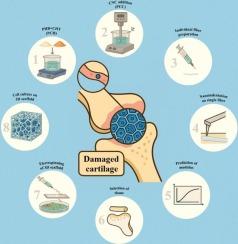The potential of cellulose nanocrystal-modified polyhydroxybutyrate/chitosan scaffolds in cartilage regeneration
IF 6.3
2区 化学
Q1 POLYMER SCIENCE
引用次数: 0
Abstract
Electrospun scaffolds are widely used in tissue engineering due to their ability to replicate the extracellular matrix (ECM) architecture, featuring a highly porous fibrous network similar to open-cell foams. This study presents an innovative modeling approach to predict the mechanical properties of nanocomposite electrospun scaffolds prior to their 3D network formation, aimed at cartilage tissue engineering applications. Scaffolds were fabricated from polyhydroxybutyrate (PHB) and chitosan (CHT) reinforced with 1, 3, and 5 wt% cellulose nanocrystals (CNCs). The modulus of the matrix and dispersed phases were first measured via AFM nanoindentation. Using these inputs, the Halpin-Tsai model predicted the modulus of individual composite nanofibers with over 90 % accuracy, which was then integrated into foam mechanical models to estimate 3D-scaffold properties. The outputs indicated that the predicted modulus values are within the physiological range suitable for skeletal tissues. Moreover, incorporation of CNCs influenced network density and bulk porosity, yielding finer fibers and enhancing scaffold characteristics, including an increase in surface roughness (300.2 to 350.1 nm), decreased water contact angle (62.64° to 55.12°), improved thermal stability (245 °C to 252 °C), and increased tensile strength (up to 4.52 MPa). Ultimately, biological evaluations demonstrated that the nanocomposite scaffolds significantly promoted cell adhesion and proliferation, as evidenced by SEM observations and a 41.04 % increase in chondrocyte viability compared to unmodified scaffolds. These findings suggest that the developed nanocomposite electrospun scaffolds offer a mechanically and biologically favorable 3D ECM-like environment, making them promising candidates for cartilage tissue regeneration.

纤维素纳米晶改性聚羟基丁酸酯/壳聚糖支架在软骨再生中的潜力
电纺丝支架由于能够复制细胞外基质(ECM)结构,具有类似于开孔泡沫的高度多孔纤维网络,在组织工程中被广泛应用。本研究提出了一种创新的建模方法,用于预测纳米复合材料静电纺丝支架在其3D网络形成之前的力学性能,旨在软骨组织工程应用。支架由聚羟基丁酸酯(PHB)和壳聚糖(CHT)制成,分别用1、3、5 wt%的纤维素纳米晶体(cnc)增强。首先利用原子力显微镜(AFM)纳米压痕测量了基体和分散相的模量。利用这些输入,Halpin-Tsai模型预测单个复合纳米纤维的模量,准确率超过90%,然后将其集成到泡沫力学模型中,以估计3d支架的性能。结果表明,预测模量值在适合骨组织的生理范围内。此外,cnc的加入影响了网络密度和体积孔隙率,产生了更细的纤维并增强了支架特性,包括表面粗糙度的增加(300.2至350.1 nm),水接触角的减少(62.64°至55.12°),热稳定性的提高(245°C至252°C),抗拉强度的提高(高达4.52 MPa)。最终,生物学评价表明,纳米复合支架显著促进细胞粘附和增殖,扫描电镜观察证明,与未修饰的支架相比,软骨细胞活力提高了41.04%。这些发现表明,所开发的纳米复合电纺丝支架提供了机械和生物学上有利的3D ecm样环境,使其成为软骨组织再生的有希望的候选者。
本文章由计算机程序翻译,如有差异,请以英文原文为准。
求助全文
约1分钟内获得全文
求助全文
来源期刊

European Polymer Journal
化学-高分子科学
CiteScore
9.90
自引率
10.00%
发文量
691
审稿时长
23 days
期刊介绍:
European Polymer Journal is dedicated to publishing work on fundamental and applied polymer chemistry and macromolecular materials. The journal covers all aspects of polymer synthesis, including polymerization mechanisms and chemical functional transformations, with a focus on novel polymers and the relationships between molecular structure and polymer properties. In addition, we welcome submissions on bio-based or renewable polymers, stimuli-responsive systems and polymer bio-hybrids. European Polymer Journal also publishes research on the biomedical application of polymers, including drug delivery and regenerative medicine. The main scope is covered but not limited to the following core research areas:
Polymer synthesis and functionalization
• Novel synthetic routes for polymerization, functional modification, controlled/living polymerization and precision polymers.
Stimuli-responsive polymers
• Including shape memory and self-healing polymers.
Supramolecular polymers and self-assembly
• Molecular recognition and higher order polymer structures.
Renewable and sustainable polymers
• Bio-based, biodegradable and anti-microbial polymers and polymeric bio-nanocomposites.
Polymers at interfaces and surfaces
• Chemistry and engineering of surfaces with biological relevance, including patterning, antifouling polymers and polymers for membrane applications.
Biomedical applications and nanomedicine
• Polymers for regenerative medicine, drug delivery molecular release and gene therapy
The scope of European Polymer Journal no longer includes Polymer Physics.
 求助内容:
求助内容: 应助结果提醒方式:
应助结果提醒方式:


